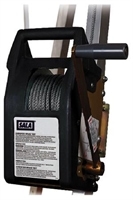Controlled Descent Devices for Emergency Rescue
Each year many workers are seriously injured or killed while performing their daily work activities in confined spaces. By nature, these work areas have limited openings for personnel entry and exit which complicates rescue, retrieval, and emergency response. Diversified Fall Protection offers a complete line of OSHA compliant manual and power driven rescue winch systems for confined space entry, rescue, and retrieval applications.

Applications
-
Davit Arm Systems
View Davit Arm Systems -
Side Entry Systems for Confined Space
View Side Entry Systems for Confined Space -
Tripod Systems
View Tripod Systems
Design Considerations
- Advanced Digital Series Winches rated for maximum working loads of 450 lbs (204 kg) with an 11:1 safety factor.
- Two cranking speeds capable of retrieval/descent from 13 ft/min (4 m/min) to 30 ft/min (9 m/min).
- Advanced Digital Winches available in 3 standard sizes.
- Designed to accommodate various diameters of cables up to 3/8” (9.5 mm) and ropes up to 5/8” (15.9 mm).
- All cable/rope assemblies come with a double locking swivel snap hook with overload indicator.
OSHA Regulations
Rescue and Descent
- Personal Fall Arrest Systems: System performance criteria. In addition to the general requirements in paragraph (c) of this section, the employer must ensure that personal fall arrest systems: 1910.140(d)(1)(i)
- Limit the maximum arresting force on the employee to 1,800 pounds (8 kN); 1910.140(d)(1)(ii)
- Bring the employee to a complete stop and limit the maximum deceleration distance the employee travels to 3.5 feet (1.1 m); 1910.140(d)(1)(iii)
- Have sufficient strength to withstand twice the potential impact energy of the employee free falling a distance of 6 feet (1.8 m), or the free fall distance permitted by the system; and... 1910.140(d)(1)(iv)
- Sustain the employee within the system/strap configuration without making contact with the employee's neck and chin area. 1910.140(d)(1)(v)
- On any horizontal lifeline that may become a vertical lifeline, the device used to connect to the horizontal lifeline is capable of locking in both directions on the lifeline. 1910.140(d)(2)(ii)
- Personal fall arrest systems are rigged in such a manner that the employee cannot free fall more than 6 feet (1.8 m) or contact a lower level. A free fall may be more than 6 feet (1.8 m) provided the employer can demonstrate the manufacturer designed the system to allow a free fall of more than 6 feet and tested the system to ensure a maximum arresting force of 1,800 pounds (8 kN) is not exceeded. 1910.140(d)(3)
- Body belts. Body belts are prohibited as part of a personal fall arrest system.
Related Documents
Talk to a fall protection specialist
Tell us about your fall protection needs, and we’ll configure a system that rises to your challenges.

